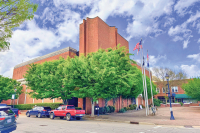Foy’s influence will endure
The praise for outgoing Waynesville Mayor Henry Foy has been plentiful. Both of the other newspapers in Haywood County have beat me to the punch, publishing glowing articles and laudatory editorials.
But I’ll still add my voice to the chorus. Foy’s tenure as mayor has just about mirrored my own career as a Western North Carolina journalist. He was elected in 1991, and I moved to the mountains in the summer of 1992. I’ve gotten to know these mountain communities at the same time I’ve gotten to know Henry Foy and watched him in public life.
Setting an example
Each year I spend covering politics and local governments, my appreciation grows for those who conduct themselves with class. It’s a trait that we all recognize when we see it but perhaps have difficulty describing. And that’s exactly the point. Someone who has class earns it by cumulative action over time. It’s not something one can sum up nicely in a campaign slogan or some pithy speech.
I distinctly remember meeting Foy’s old architectural partner, Tai Lee, soon after I moved to Waynesville. Lee had this absolutely wonderful sense of humor, and his outgoing nature endeared him to many. Foy, as many well know, is much more quiet and workmanlike.
Sometime in those first few weeks in the mountains I was introduced to Foy. Ken Wilson, then publisher of The Mountaineer — I was the editor — had the very helpful habit of giving me the background on those I met. He let me know right away that Foy and Lee were prominent town fathers who were well-liked, powerful in their own right, and just good people. Ken’s instincts were usually right on.
Related Items
As time passed what I learned to respect about Foy more than anything else was his dogged pursuit of those issues he felt strongly about. Though he has always been congenial and, as I said earlier, a person with class, he is also a fighter. His position as mayor was both a job and a passion, and he worked hard at it.
Old Asheville Road
Here’s a comparison that reflects absolutely positively on Foy’s influence on Waynesville. Consider the difference between driving into Waynesville on Russ Avenue from Lake Junaluska and driving from Lowe’s on the Old Asheville Highway.
Russ Avenue is a wide ribbon of asphalt with absolutely no attention to landscaping or pedestrian amenities. Its design encourages drivers to just fly along. Nearly every time I’m on that road my instinct is to go faster than the posted speed limit.
On Old Asheville Highway, the opposite is true. Its landscaped medians, sidewalks, traffic circle and other design elements encourage drivers to slow down and be careful. It also looks pretty darn nice for what it is — a road.
Foy and the rest of the Waynesville aldermen and staff fought hard to get that road, and they wanted even more pedestrian amenities. The county commissioners at the time wanted a road exactly like Russ Avenue. As editor of the community paper, that was one of the first issues I took on. We editorialized time and again for more planning, re-thinking design plans, viewing this roadway as an entrance to Waynesville and not just another highway.
It was a long time coming, but the state Department of Transportation for the most part came around to the town’s vision. A series of work sessions in which the public took part with experts led to a process that had community buy-in and resulted in what we now have.
Foy played a critical role, and by my estimation it was the first time a community in this region forced DOT to re-design a road and come up with something better. Now, towns in the region stand up to DOT all the time.
Recreation for all
The second great fight I remember Foy taking center stage in was for the recreation center that opened about eight years ago in Waynesville.
Haywood Regional Medical Center had only just opened its beautiful fitness center, and there was a general consensus among many in Haywood County that if Waynesville built its own it would fail. Not enough people in the county, they said.
Foy, however, did not waver. I remember hearing him speak about the need to build a place where children could go, a recreation center versus a fitness center. He had help on this one from the likes of Bob Brannon, who also knows how to stand up for what he believes in, and many others. Again, I was editor at The Mountaineer at the time and we believed just as strongly in the need to build a place for children that would provide an anchor for the town’s Vance Street Park.
Foy and the recreations supporters succeeded, and now Waynesville has a park complex that is the envy of much larger towns.
A regional influence
Part of why I admired Foy so much is that our views were very similar on many of the important issues that have faced Waynesville and other mountain communities. He saw the wisdom in building the county justice center downtown, in preserving the town’s watershed, in developing a groundbreaking land-use plan and in supporting Waynesville’s Main Street program.
These are not political beliefs but quality-of-life values. Because of the stance Waynesville took on many of these issues — and Foy had plenty of support from other elected officials, town staff and many in the community — this is a great place to live.
And other mountain towns and communities have looked at Waynesville as a leader and emulated it in many ways. In other words, the influence of a well-run town reaches beyond its borders. I travel to public hearings and town and county meetings throughout the region, and without fail I’ll hear these other leaders mention Waynesville’s successes.
Foy left his mark, and it’s one that will endure for some time in Western North Carolina.
(Scott McLeod can be reached at This email address is being protected from spambots. You need JavaScript enabled to view it..)









